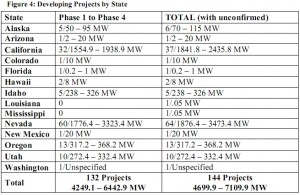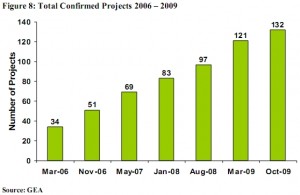Apr
21
Big Growth From Little Geothermal
April 21, 2010 | 2 Comments
Small geothermal in the US grew in the past year with 144 projects under way in 15 US states. When completed, the projects will add more than 7,000MW of baseload power capacity, roughly equivalent to the total power used in California from coal-fired power plants. That’s an average of 37.25MW each. It really adds up.
Smaller yet would be the ground source heat pump systems. More on that below. But take out the disappointing large projects and the personal or very local projects and that 7,000MW looks very good indeed.
The numbers are from the April 2010 US Geothermal Power Production and Development Update showing 26% growth. Nevada continued the lead for new geothermal energy, with more than 3,000MW under development. The fastest-growing geothermal power states are Utah, which quadrupled its geothermal power under development, New Mexico, which tripled, Idaho, which doubled, and Oregon, which reported a 50 per cent increase. Add Louisiana, Mississippi and Texas all reporting their first geothermal projects.
According to the GEA, the projects under development when completed will total a capital investment of more than $35 billion. New geothermal power projects for 2010 are in progress in 15 states from the Pacific to the Gulf Coast. The GEA identified new projects in Alaska, Arizona, California, Colorado, Hawaii, Idaho, Louisiana, Mississippi, Nevada, New Mexico, Oregon, Texas, Utah, Washington and Wyoming.
One of the more remarkable efforts is in Alaska where the Chena Hot Springs unit built in 2006 has been upgraded now twice from the first 225kW with another 225kw and 280kW totaling 780kW. Chena Hot Springs Unit II has received GRED III funding for phase one of a project that could rate from 5 to 10MW. The first project is a binary design using organic rankine cycle from a cool 165ºF source. Chena Hot Springs remains a leader and example for the U.S.
The best U.S. example is the Puna Geothermal Venture on the Big Island of Hawaii. At 35MW rating the unit runs steadily between 25 to 30 MW providing about 20 percent of Big Island’s total needs. The Puna team is showing that geothermal is a certain base load provider.
Nevada is seeing a lot of action. Vulcan has three large projects ranging from 117 to perhaps a much as 378MW. There is a veritable army of small projects starting as small as 8.4MW. At this rate it won’t be long before Nevada is self sufficient and selling power for cash – even with the lights of Las Vegas to feed.
The momentum is building – slowly. In March of 2006 the U.S. had 34 projects booked. For October 2009 the projects booked totaled 132, a 388% increase over 3½ years. Yet March 2006 saw about 2825MW installed and October 2009 3150MW installed. Some big projects would help with that number – which is why one presumes the political class likes the big ones.
As geothermal technology progresses, resources that were once non-commercial are now being actively examined as feasible possibilities. The term Enhanced Geothermal Systems (EGS) is a common reference to any resource that requires artificial stimulation and includes resources that have to be fully engineered, or ones that produce hydrothermal fluid, but sub-commercially. In certain respects EGS is still a young and not fully proven technology. However, several EGS R&D and demonstration projects are underway in the United States. As EGS technology proves to be successful, its expected to allow significantly increased extension and production from existing fields, as well as utilization of geothermal energy in what was considered previously as implausible locations.
A pittance of grant money is still committed. The U.S. Department of Energy has invested more than $5 million in a project that is currently in development and is designed to be the first geothermal operation to commercially produce geothermal energy via EGS in the lower 48 of the United States.
Another curious resource is the heat often found in oil and gas production fields as well as certain mining operations. The Southern Methodist University Geothermal Energy Program has estimated that geothermal hydrocarbon co-production (GHCP) operations in the Texas Gulf Plains has the capability of providing 1000 to 5000 MW of power. There are two of these already working.
The GHCP operation at the Jay Oilfield in Florida is planned to utilize 120,000 barrels of co-produced water with Pratt & Whitney Power Systems Pure Cycle Power System. The expected capacity of the project is 200kW but has potential for 1MW.
Rocky Mountain Oil Test Center’s project near Casper, Wyoming installed a 250 kW Ormat organic rankine cycle power unit. Through February 2009, the unit produced more than 586MWh of power from 3 million barrels of hot water online 97 percent of the time. The unit was shutdown for maintenance and repair and has been down while the field network of wells is being modified to produce a more consistent volume of water.
There is also renewed interest in the energy potential of geopressured-geothermal resources. While located in a number of states, the most significant resources are thought to be located in the northern Gulf of Mexico, particularly Texas and Louisiana both offshore and onshore. The USGS has estimated that in addition to thousands of megawatts of geothermal energy, these resources hold as much as 1,000 TCF of potentially recoverable gas.
The U.S is getting there on geothermal. Maybe the big flashy and scary to the ignorant and numb has been set back by irrational fears, but the midsized and smaller projects are coming faster, better and at lower cost. EGS might not satisfy the bureaucrats, but the market is growing for binary systems.
Lastly, the Geothermal Heat Pump industry has seen continuous growth over the last five years. The 2008 units reached 121,243 shipped, nearly double the 2006 units shipped and the capacity shipped rose to 416,105 tons or almost 500 million btu per hour. Although geothermal heat pumps tend to cost more initially than traditional heating and cooling systems, the high efficiency and ongoing cost-saving potential of geothermal heat pumps has resulted in them becoming more appealing to many more consumers.
Midsize, small and personal geothermal is going great. The large projects might be stalled, but geothermal is making it clear, almost everyone can get some power or lots of it and cut way back for heating and cooling energy requirements. Left to the individuals, small business and American’s willingness to invest and geothermal will grow to be a big industry no matter what the Federal government’s activities.
Comments
2 Comments so far




You are confusing geothermal heat pumps which are better described as ‘earth coupled’ with true geothermal heat from down below.
The two have no relationship other than a name.
The heat pumps, often referred to as ground source heat pumps (GSHP), are neat units but horribly overpriced at present. Their use is only economical (possibly) where and air source heat pump (ASHP) can’t provide winter heat due to low ambient temperatures.
The improvement in COP of a GSHP (say 5.5) over an ASHP (say 3.5) does save some power but in most situations (except as described above) you can’t pay for the improvement with the savings in 20 years.
[…] Big Growth From Little Geothermal | New Energy and Fuel […]